
|
|
|
|
Meet Buffalo Police Detective Sergeant
William E. Burns |
|
By Jack Meddoff
Deborah Kufel - Typist |
|
| His hair is white
and like silk; his face is as mild as his manner; his blue
eyes sparkle with life behind glasses. He looks more
like a bank clerk than a veteran policeman even though he
has been on the force since Dec. 31, 1900, and seems capable
of continuing for more than 40 years.
He has patrolled the waterfront when the "boys"
didn't know how to debate verbally and settled their
differences with fists.
He was a bicycle policeman during the Pan-American; he
has "cracked" famous cases like "The Clue of
the Green Hat" 35 years ago, the "Ether
Burglar" enigma in 1910, the "Payroll Bandit"
gang in 1928 and the "Hooded Mob" in 1935.
But he'll probably never again run into as fantastic a
criminal chase as the one that cut a trail all the way to
Mexico and finally ended with the electrocution of three
Blue Ribbon gangsters for the murder of Ferdinand Fechter.
"It isn't easy to get Bill Burns to talk about his
police experiences. The passing years have mellowed
him to a point of self-effacingmodesty that makes it
embarrassing to try to get him to talk about himself.
You sort of have to get "tips" from associates
on what to ask him and then be satisfied with the fragments
he hands out.
|
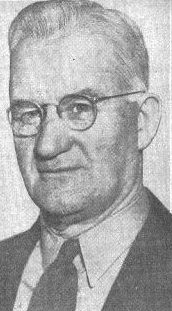 |
|
| When he became a cop in 1900, Bill
Burns got the waterfront beat where the warehouse district
prevailed-bounded by Miami, Chicago and Ohio Streets.
His particular sector was the "Flatiron
District" where gangs used to hang out and where
fist-fights and rough-and-tumble battles came as regularly
as mealtimes.
"Yes, I got into a few of those battles but nothing
much to talk about," said Mr. Burns laconically
|
|
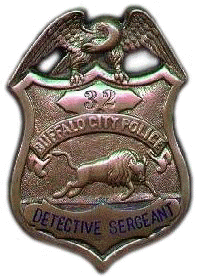 |
It was back in 1901
that he became a bicycle cop and a team that became famous
and continued for 15 years was born-the team of Bill Burns
and Fred Morganstern.
One of their first jobs as bicycle cops was to break
traffic in, at what is now Civic Center, to go right around
the circle. One of the autos of that day came down
Delaware Avenue, turned left and killed two persons.
An ordinance was passed requiring a right turn at all
circles, and Burns and Morganstern were posted at the death
spot for a month, training and making drivers go to the
right.
One gentleman in a Mercedes didn't like to be told which
way to turn
and insisted on going the other way, Mr. Burns recalled
today, so he was arrested and taken to Municipal Court. He
got a $10 fine and $1.50 costs and fought the case to the
Appellate Division but got beat, and since then folks have
been turning to the right at Delaware Avenue and the
monument without any quibbling," the veteran officer
remarked.
|
|
| It was on April 1, 1905, that Mr. Burns got
out of the "Bloody Eighth" where, incidentally, he
ran into no
untoward incidents.
He was made an acting detective and sent to old No.3,
then in Pearl Street at Chippewa.
While there he "cracked" the case that became
known as the "Clue of the Green Hat."
"Three was a fellow named James O'Connor, known as
"The Gorilla," Mr. Burns reminisced. "This
was back
in 1906 or 1907. We didn't know who he was at the time that
he terrorized the whole town by breaking in on
prominent women retiring for the night, attacking them and
then robbing them.
"He pulled 74 of those jobs without leaving a trace
as to his identity and the whole force was in an uproar.
One night we got a hurry call about a rumpus in a place
in back of the Touraine Hotel. When my partner and I
got there, all we found as a trace of the attacker-it was
the same fellow as had pulled those other 73 jobs-was
a green hat.
"Then a few days later, as I was standing in front
of the station, a woman with a bloody face came up to me
and said she couldn't stand her husband's beatings any
longer. She told me that her husband was the attacker
we had been searching for.
|
|
"I told her to go home and say nothing.
Fred and I followed. We waited around until we saw him enter
the house. Then we peeped in and saw him lying fully clothed
on the bed with a .45 beside him.
"We crashed in and I made a leap and landed on him,
with Fred landing on me. The bed collapsed and we all went
to the floor but we had stopped him getting the gun.
Later he was adjudged insane and sent to Gowanda.
A week after he was committed I walked into a saloon and
there he stood, at the bar; he had escaped. I took him in
again and he was returned to Gowanda.
|
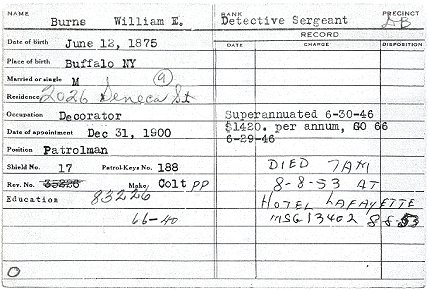 |
|
"He escaped again and the next we heard
he was pulling the attacking and robbery stuff in Canada,
around the
Thorold section.
Then we heard he was caught and sentenced to 20 years in
Kingston Prison. On the way he slugged his guard and escaped
and to this day I have never heard another word about
him."
|
|
| Along in 1910, shortly after being
appointed full-fledged detectives Burns and Morganstern were
standing in a
doorway in Genesee Street about 2 o'clock one
morning, wondering how to get their hands on the "Ether
Burglar," a fastidious gent who had looted 35 homes
by holding an ether-soaked handkerchief over the faces of
the sleeping occupants to make certain they would not
awaken and interfere.
"A young, well-dressed chap came along and we paid
no attention to him until he turned a corner, then came
back and sort of looked around as if to see if he was
being followed. That made us suspicious and we gum-shoed
after him.
He led us to his room and when we broke in and looked
around, we found all the burglary equipment he had been
using about $9000 worth of jewelry he had collected from his
victims."
The only time Mr. Burns ever killed a man was in 1916-the
year, incidentally, in which the team of Burns and
Morganstern was broken up by higher-ups at headquarters.
The man he killed was known as the "Little Matze."
|
|
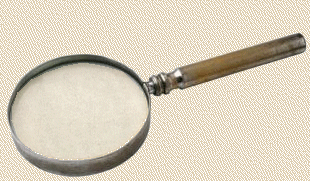 |
"There was a
gang running around town in a car holding up gas stations
and stores and every place where they might get money,"
Mr. Burns said. I was in charge of the gangster squad for
the 11th and 12th precincts. We just couldn't get a 'break'
that would help us to capture this gang that was raising the
dickens around town."
Then, one day, a fellow came up to me. I knew him as 'Darky'
but his right name was Walter Cymny. His face
was a mess; he had been badly beaten.
He said: "You're looking for the guys what's doing
all these holdups and I know where you can find 'em; they
did this to me and they ain't getting away with it."
|
|
| "He told me where there was a big wedding
party attended by the gang we wanted to get. I went there. I
looked in, saw them dancing around, about 20 couples, with
the men in shirt-sleeves and gats sticking out of their hip
pockets.
"I went in and grabbed the two I wanted-'Little
Matze'and a chap known as 'Jack Rabbit,' right name,
Lawrence
Ziblonek.
I had quite a time with them; three was a free-for-all
and I got kind of mussed up. 'Little Matze' broke
loose from me and pulled his gun. He was a bum shot;
he fired six bullets and not one hit me.
|

|
|
| "By that time I was able to get my own
gun out and shot him twice.
Some of hi pals grabbed him and ran out. They left him in
front of a saloon where Johnny Reville later found
him.
He was taken to Emergency Hospital where just before he
died, he confessed a lot of things.
We got 'Jack Rabbit' and the others in the gang-Frank
Lubeciki, alias Bullock; Frank Shultz, known as
'Sharpshooter'-and they went to prison for long stretches.
Mr. Burns became a detective-sergeant in 1918 and the
first he knew of it was when he read it in a newspaper
while in Cleveland on police business.
|
|
| A bit of sleuthing by Mr. Burns in 1928 led to
the arrest of a holdup mob that ultimately confessed to more
than 65 stick-ups in Buffalo.
One of the victims of the mob was a storekeeper in
vicinity of the former Donner Steel Company, now Republic
Steel. He used to cash steel workers' checks and the loot of
the gang that robbed him included some of the checks.
Mr. Burns discovered that two of the checks were used in
the purchase of an automobile in San Francisco.
From police there Mr. Burns got the name of the purchaser
and the license plate numbers."
|
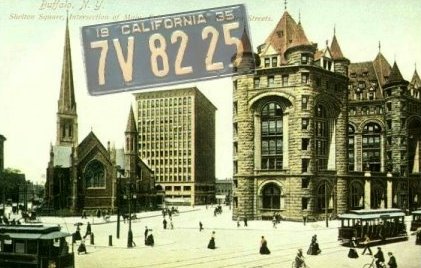
|
|
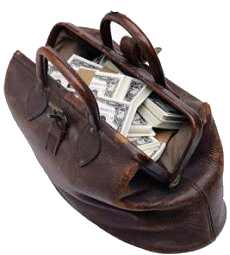 |
One day near Shelton
Square I saw a car with California plates and there was my
man," he recalled. "I jumped on the running board,
discovered that the fellow behind the wheel was a
criminal with a record and the rest was easy."In 1935
the "Hooded Mob" made its appearance.
Two men, one wearing a hood with two eye-holes and the
other wearing a muffler over his face, would hold up a store
and then escape in a waiting car driven by a woman beside
whom invariably sat a poodle dog.
"They got away with about 35 jobs before we finally
caught up to where their hang-out was and when we crashed
in, we found a number of phony auto license plates, the
hood, muffler, loaded guns and plenty of loot."
"The woman in the gang was a tough one; she and the
leader had met in San Francisco, had done time in San
Quentin and , on being released, had headed East. |
|
| They settled down in Buffalo and got away
with 35 jobs but the 36th didn't turn out so good for them.
They went to prison. And two men who had been arrested
for an Amherst street store holdup and who protested their
innocence were proved innocent by the confession of the
"Hooded Mob" gang.
"At this point Mr. Burns began to realize that he
had been reminiscing quite a bit.
"That'll be enough," he said.
"You'll have me going on like this for hours.
With all the different types of jobs I've
been identified with, though, the one I like best is the one
I have now and the one I have had through most of my career
with some exceptions-watching out for 'con' men and
pickpockets."
And, as a matter of fact and also as a matter of record,
Bill Burns probably has caught as many and caused the
arrest of as many pick pockets and "con" men as
any cop on any force in any city in the country of a size
comparable to Buffalo.
|
|
|

